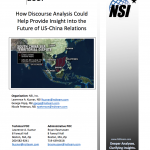Relevant Prior NSI Discourse Work
A war of words, such as that between China and the US, often contains clues to future actions that adversaries may take. NSI’s approach to discourse analysis is designed to uncover these clues and provide advance indicators and warnings (I&W) of impending political actions. Discourse is defined as language in use, involving not only what is said, but how it is said and how the broader political and cultural context influences its interpretation. Caution must be used when interpreting discourse for a variety of reasons: our interpretation of discourse is heavily influenced by our own biases—we may not be receiving the same message that adversaries are trying to convey, a statement in one context may take on a different meaning in another context, and adversaries may be purposefully deceptive and manipulative in their use of discourse. NSI’s approach to discourse analysis combines analysis of cultural context, coding of subtle themes and ways of using language of which speakers are often unaware, and quantitative analysis of discourse in order to mitigate the challenges of this field of study. The result is a culturally and contextually sensitive analysis of meaning that can capture I&W that an adversary is unaware he/she or they are revealing.
The South China Sea disputes have a long history. The protagonists frequently issue statements, and actions are a veritable fire hose of gray zone activities. This creates a large volume of data, permitting the statistical analysis of correlations between discursive I&W and the amount of gray zone activity occurring during any period of time. The key metric of discursive I&W is the density of themes (issues, culturally and psychologically salient concepts) and rhetorical devices (ways of using language such as metaphors, sarcasm, repetition, pejoratives). Correlations between discursive I&W and the number of gray zone activities (Island building, aggressive nautical maneuvers, fly overs) over the next six months were monitored from 2002 to 2016.
A number of discursive I&W emerged and were very strongly correlated with subsequent gray zone activities by all parties. This blog post will focus on those that predict Chinese actions.
Six months prior to an escalation of gray zone activities, Chinese leaders increase their mentions of conspiracies, their right to self-defense, their right to be equal to other nations (namely the US), and prior gray zone activities they perceive to have been committed against them. Chinese leaders also employ rhetorical devices such as rhetorical questions and sarcasm more than six months before they escalate gray zone activities. The correlations are very strong and highly statistically significant. The following figure depicting the density with which Chinese leaders mention their national rights and the subsequent escalation of Chinese gray zone activities illustrates the predictive quality of discursive I&W.
What Might We Expect To Come
The question remains: in the escalated war of words, what might we expect for the future?
In these recent events, the Chinese invoked their national rights, perceived President-elect Donald Trump’s call with Taiwanese President Tsai Ing-wen as a gray zone activity, and voiced their grievances concerning the US’s perceived incompliance with their One China policy. The Chinese followed up with gray zone activities, including sending frigates through the Taiwan Strait. Similarly, following a January exchange in which China once again asserted its rights and perceived the US’s rhetoric as aggressive, there was an unsafe incident involving US naval and Chinese military aircrafts. Interestingly, and perhaps coincidentally, that very day, President Trump had a communique with Chinese President Xi Jinping.
This sequence of current events accurately reflects the trends observed in NSI’s previous discourse work. China’s reiteration of their national rights and their perception of the US’s actions as gray are examples of common Chinese indicators and warnings of future gray zone activity. So, although we have already seen some gray zone activities on China’s end, we can expect to see more in the coming six months.
Intensifying rhetoric and rising tensions are following the patterns that we have identified. The US currently has an aircraft carrier cruising through the South China Sea, which was followed by a Chinese assertion of sovereignty and the need for peace, and all the while, the Chinese finished work on buildings on the Spratley Islands that are capable of housing missiles. And the drama continues.
We expect future gray zone activities to be signaled by escalations in rhetoric. Namely, we expect China to continue to assert their rights in the region and to cite US gray zone activities in advance of their own gray zone activities. We also expect escalations in US rhetoric to lead to further escalations in Chinese rhetoric and subsequent gray zone actions.
